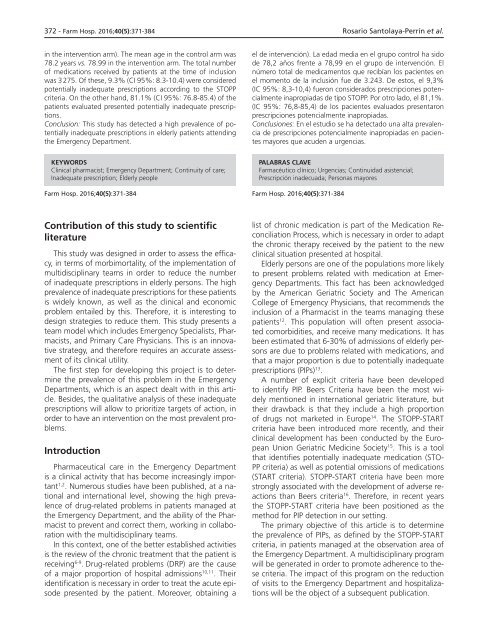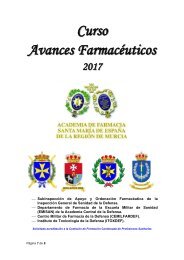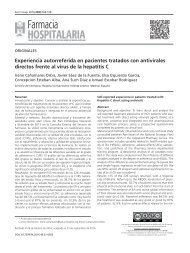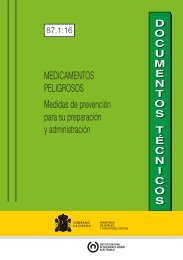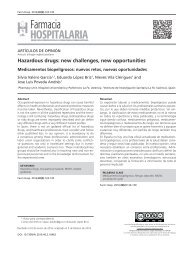155_10465
155_10465
155_10465
Create successful ePaper yourself
Turn your PDF publications into a flip-book with our unique Google optimized e-Paper software.
372 - Farm Hosp. 2016;40(5):371-384 Rosario Santolaya-Perrín et al.<br />
in the intervention arm). The mean age in the control arm was<br />
78.2 years vs. 78.99 in the intervention arm. The total number<br />
of medications received by patients at the time of inclusion<br />
was 3 275. Of these, 9.3% (CI 95%: 8.3-10.4) were considered<br />
potentially inadequate prescriptions according to the STOPP<br />
criteria. On the other hand, 81.1% (CI 95%: 76.8-85.4) of the<br />
patients evaluated presented potentially inadequate prescriptions.<br />
Conclusion: This study has detected a high prevalence of potentially<br />
inadequate prescriptions in elderly patients attending<br />
the Emergency Department.<br />
el de intervención). La edad media en el grupo control ha sido<br />
de 78,2 años frente a 78,99 en el grupo de intervención. El<br />
número total de medicamentos que recibían los pacientes en<br />
el momento de la inclusión fue de 3.243. De estos, el 9,3%<br />
(IC 95%: 8,3-10,4) fueron considerados prescripciones potencialmente<br />
inapropiadas de tipo STOPP. Por otro lado, el 81,1%.<br />
(IC 95%: 76,8-85,4) de los pacientes evaluados presentaron<br />
prescripciones potencialmente inapropiadas.<br />
Conclusiones: En el estudio se ha detectado una alta prevalencia<br />
de prescripciones potencialmente inapropiadas en pacientes<br />
mayores que acuden a urgencias.<br />
KEYWORDS<br />
Clinical pharmacist; Emergency Department; Continuity of care;<br />
Inadequate prescription; Elderly people<br />
Farm Hosp. 2016;40(5):371-384<br />
PALABRAS CLAVE<br />
Farmacéutico clínico; Urgencias; Continuidad asistencial;<br />
Prescripción inadecuada; Personas mayores<br />
Farm Hosp. 2016;40(5):371-384<br />
Contribution of this study to scientific<br />
literature<br />
This study was designed in order to assess the efficacy,<br />
in terms of morbimortality, of the implementation of<br />
multidisciplinary teams in order to reduce the number<br />
of inadequate prescriptions in elderly persons. The high<br />
prevalence of inadequate prescriptions for these patients<br />
is widely known, as well as the clinical and economic<br />
problem entailed by this. Therefore, it is interesting to<br />
design strategies to reduce them. This study presents a<br />
team model which includes Emergency Specialists, Pharmacists,<br />
and Primary Care Physicians. This is an innovative<br />
strategy, and therefore requires an accurate assessment<br />
of its clinical utility.<br />
The first step for developing this project is to determine<br />
the prevalence of this problem in the Emergency<br />
Departments, which is an aspect dealt with in this article.<br />
Besides, the qualitative analysis of these inadequate<br />
prescriptions will allow to prioritize targets of action, in<br />
order to have an intervention on the most prevalent problems.<br />
Introduction<br />
Pharmaceutical care in the Emergency Department<br />
is a clinical activity that has become increasingly important<br />
1,2 . Numerous studies have been published, at a national<br />
and international level, showing the high prevalence<br />
of drug-related problems in patients managed at<br />
the Emergency Department, and the ability of the Pharmacist<br />
to prevent and correct them, working in collaboration<br />
with the multidisciplinary teams.<br />
In this context, one of the better established activities<br />
is the review of the chronic treatment that the patient is<br />
receiving 6-9 . Drug-related problems (DRP) are the cause<br />
of a major proportion of hospital admissions 10,11 . Their<br />
identification is necessary in order to treat the acute episode<br />
presented by the patient. Moreover, obtaining a<br />
list of chronic medication is part of the Medication Reconciliation<br />
Process, which is necessary in order to adapt<br />
the chronic therapy received by the patient to the new<br />
clinical situation presented at hospital.<br />
Elderly persons are one of the populations more likely<br />
to present problems related with medication at Emergency<br />
Departments. This fact has been acknowledged<br />
by the American Geriatric Society and The American<br />
College of Emergency Physicians, that recommends the<br />
inclusion of a Pharmacist in the teams managing these<br />
patients 12 . This population will often present associated<br />
comorbidities, and receive many medications. It has<br />
been estimated that 6-30% of admissions of elderly persons<br />
are due to problems related with medications, and<br />
that a major proportion is due to potentially inadequate<br />
prescriptions (PIPs) 13 .<br />
A number of explicit criteria have been developed<br />
to identify PIP. Beers Criteria have been the most widely<br />
mentioned in international geriatric literature, but<br />
their drawback is that they include a high proportion<br />
of drugs not marketed in Europe 14 . The STOPP-START<br />
criteria have been introduced more recently, and their<br />
clinical development has been conducted by the European<br />
Union Geriatric Medicine Society 15 . This is a tool<br />
that identifies potentially inadequate medication (STO-<br />
PP criteria) as well as potential omissions of medications<br />
(START criteria). STOPP-START criteria have been more<br />
strongly associated with the development of adverse reactions<br />
than Beers criteria 16 . Therefore, in recent years<br />
the STOPP-START criteria have been positioned as the<br />
method for PIP detection in our setting.<br />
The primary objective of this article is to determine<br />
the prevalence of PIPs, as defined by the STOPP-START<br />
criteria, in patients managed at the observation area of<br />
the Emergency Department. A multidisciplinary program<br />
will be generated in order to promote adherence to these<br />
criteria. The impact of this program on the reduction<br />
of visits to the Emergency Department and hospitalizations<br />
will be the object of a subsequent publication.


